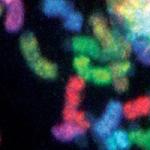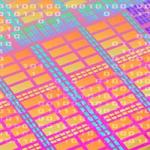
Elissa P. Lei, Ph.D.
Senior Investigator
Nuclear Organization and Gene Expression Section, Laboratory of Biochemistry & Genetics
NIDDK
Research Topics
Research Goal
The work performed in my laboratory will help determine how the 3-dimensional organization of DNA within each cell affects cellular function and identity throughout development.
Current Research
Importance of genome organization and our approaches
Control of gene expression requires proper 3D organization of DNA at the level of chromatin. We study how genome organization contributes to regulation of gene expression, which ultimately controls how a single genome can give rise to a myriad of distinct cell types with different functions and properties. We utilize insect and mammalian model systems to study conserved aspects of genome organization in various developing tissues, such as the Drosophila brain and the mouse retina. Our experimental approaches include genetics, imaging, biochemistry, structural biology, genomics, and computational biology, including artificial intelligence.
Relevance of chromatin insulators
Chromatin insulators are DNA-protein complexes that influence gene expression by establishing chromatin domains subject to distinct transcriptional controls, likely through alteration of their spatial organization. Insulators are required for the formation of topologically associating domains (TADs), and on a local scale, insulators enforce the strict specific and temporal expression of loci with complex enhancer and/or promoter configuration. Examples include metazoan Hox genes, master regulators of body segmentation, and the vertebrate beta-globin locus, which changes in expression during erythroid development. Loss of insulator activity can result in substantial positive or negative changes in gene expression, culminating in disease, defects in development, and/or lethality. For example, deletion of insulator binding sites at the H19/IGF2 imprinting center have been implicated in Beckwith-Wiedemann syndrome and Wilms’ Tumor. Moreover, recent studies have shown that loss of insulator activity in IDH1 mutant gliomas and T cell acute lymphoblastic leukemias leads to disruption of boundaries between chromatin domains and subsequent oncogene activation.
Tissue-specific regulation of insulator activity and antagonism of chromatin looping
Drosophila harbors the largest diversity of known chromatin insulator complexes. We identified two novel, tissue-specific negative regulators of gypsy insulator function that affect both enhancer blocking and barrier activities. Shep can bind directly to Su(Hw) as well as another core component of the gypsy insulator complex, potentially competing with inter- or intra-insulator complex interactions and thereby neutralizing insulator activity. Shep is required for neuronal remodeling during development and is highly enriched in the CNS, perhaps serving to negatively regulate insulator function in these cell types to promote CNS-specific gene expression programs. We found that Shep can antagonize enhancer-promoter looping of one of its downstream transcriptional targets in a temporal manner. Shep harbors two highly conserved RNA recognition motifs (RRMs), and genetic evidence points to a functional relationship between its RNA-binding capability and insulator function. Intriguingly, Shep’s RNA binding capability has also been shown to affect metabolism of fat cells and organismal energy homeostasis. In contrast, Rump, which contains 3 RRMs, antagonizes gypsy insulator activity in tissues outside of the CNS. Both Shep and Rump are conserved to humans, and importantly, one human ortholog of Shep has been implicated in type 2 diabetes in genome-wide association studies. We have successfully knocked out Shep orthologs in mice in order to study their function.
RNA-dependent insulator function
Using RNA immunoprecipitation followed by deep sequencing (RIP-seq), we made the striking finding that certain mRNAs, including that encoding Su(Hw) itself, associate stably with gypsy insulator complexes. Expression of untranslatable versions of these mRNAs alters insulator body localization and promotes insulator activity. We speculate that these mRNAs also harbor a noncoding function, such as acting as a scaffold for insulator complexes at specific subnuclear locations. We recently identified a novel RNA-binding protein, Isha, that binds to the su(Hw) mRNA and is required for gypsy insulator function.
(This work was highlighted in Editors' Choice, Riddihough G. Noncoding mRNAs. Science, (341)6149: 938, 2013.)
Biography
- Senior Investigator, Nuclear Organization and Gene Expression Section, Laboratory of Biochemistry and Genetics, NIDDK, NIH, 2021-present
- Nancy Nossal Mentorship Award, NIDDK, NIH, 2020
- Senior Investigator, Nuclear Organization and Gene Expression Section, Laboratory of Cellular and Developmental Biology, NIDDK, NIH, 2014-2020
- Investigator, Laboratory of Cellular and Developmental Biology NIDDK, NIH, 2006-2014
- Postdoctoral Fellow, Laboratory of Victor G. Corces, Johns Hopkins University, 2003-2006
- Ph.D., Laboratory of Pamela A. Silver, Harvard Medical School, 1997-2002
Selected Publications
- Chen D, Keremane S, Wang S, Lei EP. CTCF regulates global chromatin accessibility and transcription during rod photoreceptor development. Proc Natl Acad Sci U S A. 2025;122(9):e2416384122.
- Bhattacharya M, Lyda SF, Lei EP. Chromatin insulator mechanisms ensure accurate gene expression by controlling overall 3D genome organization. Curr Opin Genet Dev. 2024;87:102208.
- Chen S, Rosin LF, Pegoraro G, Moshkovich N, Murphy PJ, Yu G, Lei EP. NURF301 contributes to gypsy chromatin insulator-mediated nuclear organization. Nucleic Acids Res. 2022;50(14):7906-7924.
- Chen D, McManus CE, Radmanesh B, Matzat LH, Lei EP. Temporal inhibition of chromatin looping and enhancer accessibility during neuronal remodeling. Nat Commun. 2021;12(1):6366.
- Bag I, Chen S, Rosin LF, Chen Y, Liu CY, Yu GY, Lei EP. M1BP cooperates with CP190 to activate transcription at TAD borders and promote chromatin insulator activity. Nat Commun. 2021;12(1):4170.
Related Scientific Focus Areas
This page was last updated on Thursday, August 7, 2025




